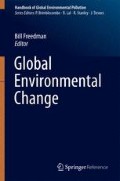Abstract
Atmospheric greenhouse gas emissions show no declining trend, which has motivated ideas of deliberate climate engineering by modifying the reflectivity of the Earth. One suggested method is cloud brightening, in which artificial emissions of aerosol particles are used to enhance the reflectivity of clouds. While climate models suggest that cloud brightening might be able to offset at least some of the predicted global warming, large uncertainties remain related to the efficiency as well as to the environmental and regional climate impacts of the method.
Access this chapter
Tax calculation will be finalised at checkout
Purchases are for personal use only
References
Jones A, Haywood J, Boucher O (2009) Climate impacts of geoengineering marine stratocumulus clouds. J Geophys Res 114:D10106. doi:10.1029/2008JD011450
Korhonen H, Carslaw KS, Romakkaniemi S (2010) Enhancement of marine cloud albedo via controlled sea spray injections: a global model study of the influence of emission rates, microphysics and transport. Atmos Chem Phys 10:4133–4143
Latham J (1990) Control of global warming? Nature 347:339–340
Latham J, Rasch P, Chen C-C, Kettles L, Gadian A, Gettelman A, Morrison H, Bower K, Chourlaton T (2008) Global temperature stabilization via controlled albedo enhancement of low-level maritime clouds. Philos Trans R Soc A 366:3969–3987
Partanen A-I, Kokkola H, Romakkaniemi S, Kerminen V-M, Lehtinen KEJ, Bergman T, Arola A, Korhonen H (2012) Direct and indirect effects of sea spray geoengineering and the role of injected particle size. J Geophys Res 117, D02203, doi:10.1029/2011JD016428
Quinn PK, Bates TS (2011) The case against climate regulation via oceanic phytoplankton sulphur emissions. Nature 480:51–56
Rasch P, Latham J, Chen C-C (2009) Geoengineering by cloud seeding: influence on sea ice and climate system. Environ Res Lett 4. doi:10.1088/1748-9326/4/4/045112
Salter S, Sortino G, Latham J (2008) Sea-going hardware for the cloud albedo method of reversing global warming. Philos Trans R Soc A 366:3989–4006
Wang H, Rasch PJ, Feingold G (2011) Manipulating marine stratocumulus cloud amount and albedo: a process-modelling study of aerosol-cloud-precipitation interactions in response to injection of cloud condensation nuclei. Atmos Chem Phys 11:4237–4249
Author information
Authors and Affiliations
Corresponding author
Editor information
Editors and Affiliations
Rights and permissions
Copyright information
© 2014 Springer Science+Business Media Dordrecht
About this entry
Cite this entry
Korhonen, H., Partanen, AI. (2014). Cloud Brightening and Climate Change. In: Freedman, B. (eds) Global Environmental Change. Handbook of Global Environmental Pollution, vol 1. Springer, Dordrecht. https://doi.org/10.1007/978-94-007-5784-4_50
Download citation
DOI: https://doi.org/10.1007/978-94-007-5784-4_50
Published:
Publisher Name: Springer, Dordrecht
Print ISBN: 978-94-007-5783-7
Online ISBN: 978-94-007-5784-4
eBook Packages: Earth and Environmental ScienceReference Module Physical and Materials ScienceReference Module Earth and Environmental Sciences

